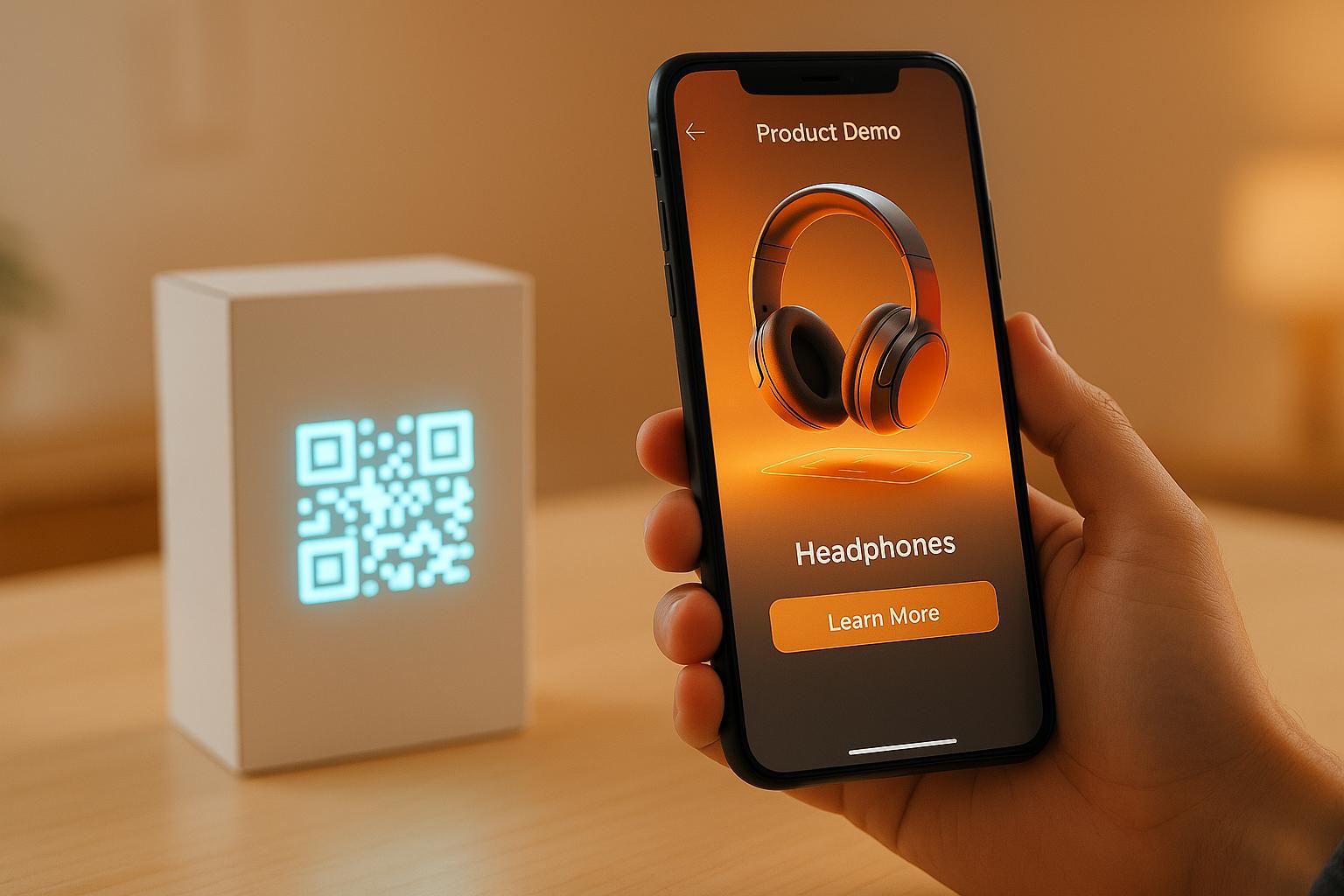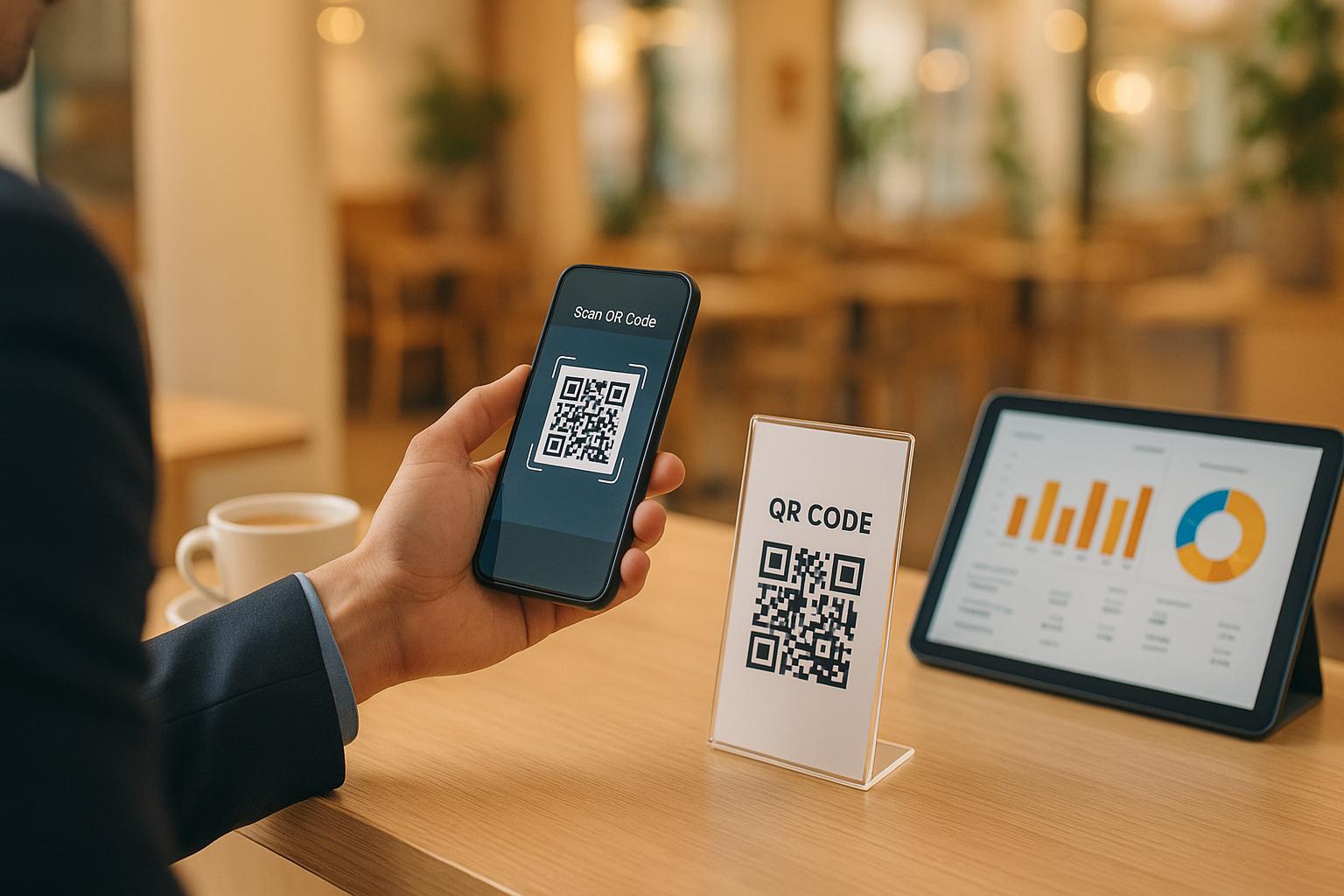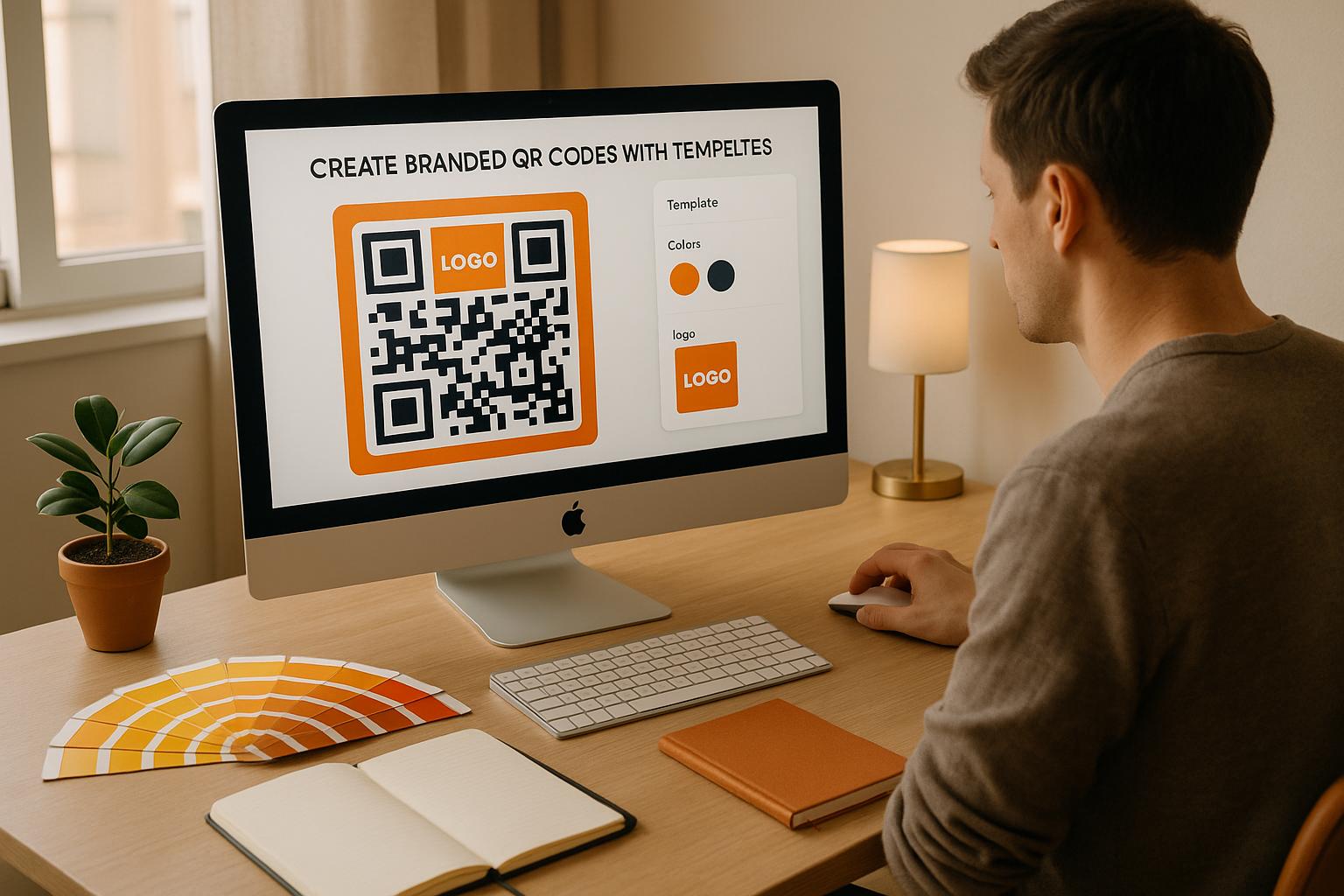AR QR codes let you scan a code with your smartphone to instantly access interactive, augmented reality (AR) experiences. These codes are changing how businesses showcase products by offering 3D models, virtual demos, and immersive content directly through a mobile browser – no extra apps needed.
Here’s why AR QR codes matter:
- Engage customers: 79% of shoppers want AR tools to explore products before buying.
- Boost sales: Products with AR content see 94% higher conversion rates.
- Reduce returns: Retailers using AR report 22–40% fewer returns.
- Easy updates: Dynamic QR codes allow content changes without reprinting.
How it works:
- Scan the code on packaging, ads, or displays.
- A 3D product model or AR experience launches in your browser.
- Users can interact with the product – rotate, zoom, or see it in their space.
AR QR codes are used by brands like IKEA, Toyota, and Puma to create interactive shopping experiences. Tools like Pageloot make it simple to create, test, and track these codes, ensuring they work seamlessly across devices. With AR QR codes, businesses can offer engaging, memorable product demonstrations that drive customer action.
3D Scanning & AR QR Code Creation for Marketing & E-Commerce | ar-code.com
How AR QR Codes Work in Product Demonstrations
AR QR codes are reshaping how businesses showcase products, offering a seamless blend of the physical and digital worlds. Unlike standard QR codes that simply redirect to a webpage, AR QR codes unlock immersive augmented reality (AR) experiences. Let’s break down the technology and the user journey that make these demonstrations so impactful.
The Technology Behind AR QR Codes
AR QR codes combine traditional QR scanning with advanced AR technology. They rely on AI, computer vision, real-time rendering, and spatial mapping to deliver interactive experiences – all without requiring specialized apps or hardware. When you generate an AR QR code, it activates web-based AR content. Using a device’s camera, the technology detects the physical environment and overlays digital elements, such as 3D models, animations, or interactive displays, directly onto the screen.
One of the biggest advantages here is accessibility. By eliminating the need for extra apps or equipment, AR QR codes make it easier for businesses and consumers to embrace AR technology.
Here’s how users interact with this tech.
User Journey with AR QR Codes
The process is designed to engage customers while keeping things simple. When users encounter an AR QR code – whether on product packaging, in-store displays, or marketing materials – they scan it with their smartphone. The AR experience launches right in their mobile browser or through a lightweight app interface. Once the camera activates, digital elements appear in the real-world setting, allowing users to interact with 3D models, animations, or other features.
For instance, Puma incorporated AR QR codes in their flagship store, placing them on signs and shoe tags. Scanning these codes connected customers to an AR experience featuring a playful feline mascot. Shoppers could take selfies with the mascot or get directions to specific store sections. It’s a great example of how AR QR codes can create both functional and memorable experiences.
How AR Enhances Product Demonstrations
AR QR codes elevate product demos by offering features that traditional methods simply can’t match. They let customers explore 3D versions of products, helping them make informed decisions without needing physical interaction. Through interactive displays and contextual overlays, AR brings product details to life in ways static images can’t replicate. Take IKEA, for example – they use AR QR codes in their Place app to show customers how furniture would look in their homes.
The benefits don’t stop there. Immersive AR experiences significantly boost engagement. Studies show that 79% of consumers are interested in using AR to interact with products before purchasing. These experiences build emotional connections with customers, often leading to higher conversion rates and fewer returns. Plus, businesses can use a dynamic QR code generator to update AR content without reprinting materials, making campaigns flexible and cost-efficient.
Step-by-step guide to creating AR QR codes for product demos
Creating AR QR codes for product demos involves a straightforward process, starting from content preparation to testing and deployment. By following these steps, you can ensure your interactive AR experience runs smoothly and effectively engages your audience.
Prerequisites and preparation
Before you start creating AR QR codes, there are a few essentials you’ll need to gather. First, secure your 3D product assets or digital content. This could be anything from 3D models and animations to immersive videos designed to highlight your product’s key features. These assets can be created in-house or sourced from external designers.
Next, choose a platform to host your AR content. Platforms like ZapWorks and Blippar are user-friendly options that handle technical aspects like spatial mapping and real-time rendering. Opting for a platform that supports web-based AR can make the experience seamless for your audience, as they won’t need to download extra apps.
You’ll also need a QR code generator that supports AR integration. Tools like Pageloot allow you to create dynamic QR codes that can be updated even after deployment.
Finally, ensure you have access to reliable internet and test devices that reflect what your target audience might use. Keep in mind that older smartphones may struggle with complex AR content, so plan for compatibility across a range of devices.
Once you’ve gathered these essentials, you’re ready to dive into the creation process.
Steps to create and implement AR QR codes
The process of creating and implementing AR QR codes involves several key steps:
- Create or source your AR content: Develop 3D models or adapt existing product visuals into interactive formats. Your content should provide more value than static images, offering a deeper look into your product’s features.
- Host your content on an AR platform: Upload your 3D models, configure interactive elements, and set up the user interface on your chosen AR platform. Test thoroughly to ensure smooth loading times, high visual quality, and responsive interactions.
- Generate your QR code: Use a QR code generator to create a code that links directly to your AR content. Dynamic QR codes are particularly useful since they allow you to update the content without needing to reprint the code.
- Customize your QR code: Add your company logo, adjust colors to match your branding, and ensure the design aligns with your marketing materials. Just make sure the customization doesn’t interfere with the code’s scannability – maintain good contrast and avoid obstructing the scanning area.
- Test your QR code: Check its functionality across various devices, operating systems, and network conditions. Test on Wi-Fi, 4G, and 5G connections, as well as slower networks, to ensure compatibility.
- Distribute your QR codes: Strategically place your QR codes on product packaging, in-store displays, marketing flyers, or even business cards. Think about where and how customers will encounter the codes, and ensure scanning conditions (like lighting and space) are optimal.
Testing and analytics
Once your AR QR codes are in use, testing and analytics will help you refine the experience. Test your AR content on a variety of devices and networks, including older smartphones, to ensure compatibility. If some devices struggle with the AR experience, consider offering a simplified version of the content.
Optimize scanning conditions by testing the QR codes in different lighting scenarios and at varying distances. Make sure the code has enough contrast with its background and that its design doesn’t interfere with scannability. Using a higher error correction level can also help keep the code functional, even if it gets partially damaged.
In the analytics phase, track metrics like scan counts, scan locations, device types, and the time of day users interact with your AR content. These insights can reveal when and where customers are most engaged. If you notice drop-offs in the user journey – like long loading times or confusing interfaces – you can make adjustments without needing to reprint the QR codes. This is where dynamic codes prove especially useful.
Regular monitoring is also key for maintaining a smooth experience. Check periodically to ensure your AR content is accessible and that no technical issues have arisen. Inspect printed QR codes for damage caused by smudging, sunlight, or wear and tear.
To further enhance the user experience, include a short URL near the QR code as a backup. This way, if scanning fails for any reason, customers can still access your AR content without frustration.
sbb-itb-74874c9
Benefits and Advanced Applications of AR QR Codes
Better Engagement and Interactivity
AR QR codes transform static presentations into dynamic, immersive experiences that merge the physical and digital worlds. Instead of just viewing images or watching videos, customers can interact with products in ways that feel natural and engaging. This meets a growing consumer desire – 79% of shoppers express interest in using AR to engage with products before making a purchase.
With AR, customers can explore products more actively. They can rotate 3D models, experiment with different colors, visualize items in their own space, and examine features at their own pace. These interactive experiences not only help brands stand out but also leave a lasting impression, especially in competitive markets where traditional marketing struggles to grab attention. The combination of novelty and functionality sparks immediate interest while fostering long-term brand recall. Plus, AR provides insights into customer behavior, showing which features captivate users and where engagement might drop off. This feedback opens up opportunities for exciting applications across various industries.
Advanced Use Cases for AR QR Codes
AR QR codes are making waves in industries like entertainment and finance, showcasing their versatility.
For example, Cinemark used AR QR codes to build excitement for Gladiator II. They introduced the AR-ena Popcorn Bucket, designed to look like a Roman Colosseum. Scanning the QR code on the bucket’s bottom brought a gladiator fight to life on a smartphone screen.
In the financial sector, British fintech company Revolut launched a creative AR campaign to promote its Ultra membership. They placed "Platinum Portals", silver structures with QR codes, across European cities. Scanning these codes transported users to an AR experience that showcased Revolut’s premium metal Ultra card.
"Revolut wanted to welcome everyone into a ‘World of Exclusivity.’ Our mission was to make this launch not just another banking plan, but a moment to remember."
These examples highlight how AR QR codes can deliver personalized, location-specific experiences. They can adapt in real-time based on factors like the time of day, user location, or previous interactions, creating a more tailored and impactful engagement.
How Pageloot Simplifies AR QR Code Campaigns

To make the most of AR QR codes, managing campaigns efficiently is key. Pageloot’s platform is designed to tackle the complexities of running sophisticated QR code initiatives.
One standout feature is its dynamic QR code generator. This tool allows you to update AR content without needing to reprint physical codes – a game-changer when fixing technical issues, refreshing 3D models, or responding to user feedback.
Pageloot also enables full customization of QR codes to align with your branding, while advanced analytics provide actionable insights. You can track when and where users interact with your AR content, what devices they use, and how long they engage. These insights reveal patterns like peak interaction times or geographic hotspots, helping you refine future campaigns.
For businesses juggling multiple AR projects, Pageloot simplifies campaign management. You can create QR codes for different products, monitor performance across channels, and make informed decisions about which AR experiences resonate most with your audience.
The platform also integrates seamlessly with broader marketing tools, allowing AR QR code campaigns to trigger follow-up actions like emails, social media engagement, or CRM updates. This ensures that AR interactions translate into measurable business results.
With the AR/VR market expected to grow to $370 billion by 2034, having scalable tools like Pageloot is becoming increasingly important. The platform not only supports the technical demands of AR QR code campaigns but also adapts to your evolving marketing strategies.
Best practices and security considerations
Key best practices
To create effective AR QR code campaigns, start with mobile-optimized, fast-loading AR content. Test your AR experiences on a variety of devices and networks to ensure compatibility. For older devices or slower connections, consider using lighter 3D models to maintain performance.
Include clear and direct calls-to-action (CTAs) within your AR interface. After users engage with your AR experience, guide them on what to do next – whether it’s visiting your website, making a purchase, or sharing the experience on social media. CTAs should be easy to tap and prominently placed.
Make sure QR codes are easy to access and scan. They should be clearly visible, appropriately sized (at least 1 inch or 2.5 cm square), and placed in well-lit, unobstructed areas for hassle-free scanning.
Keep your AR design simple and focused. While AR offers plenty of creative opportunities, avoid overwhelming users with too much information or too many interactive elements. Instead, highlight two or three key product features that align with your audience’s interests.
Regularly update your AR content to keep it engaging and relevant. Unlike static marketing materials, AR experiences can be refreshed to reflect seasonal promotions, new product launches, or updated branding. Tools like Pageloot’s dynamic QR code generator make it easy to update content without needing to reprint codes.
Security measures for AR QR codes
While following best practices ensures optimal performance, securing your AR QR codes is equally important. The interactive nature of AR experiences introduces potential risks, and proactive measures can protect both your users and your brand.
Start with secure hosting for your AR content. Use servers with SSL/TLS encryption and ensure they are updated with the latest security patches. A secure connection, indicated by the padlock icon in browsers, is especially critical when collecting user information during the experience.
Implement access controls to limit misuse. Features like geofencing can restrict access to specific locations, making them ideal for events or regional campaigns. You can also set scan limits to prevent bots from overloading your system or distorting analytics.
To combat counterfeit QR codes, customize them with your company’s branding. Adding elements like your logo or brand colors not only enhances their appearance but also helps users verify authenticity. When you create a QR code with Pageloot, these customizations can make tampering more noticeable.
Follow data protection protocols that comply with regulations like GDPR or CCPA. Be transparent about what data your AR experience collects and how it will be used. Collect only the information necessary and provide users with clear opt-out options to build trust.
Educate users to recognize legitimate QR codes. Include a brief description near your codes, such as “Scan to explore our new product in AR,” so users know what to expect after scanning. This simple step can help prevent scams.
Strengthen backend security by using multi-factor authentication (MFA), especially if your QR codes integrate with sensitive systems like customer accounts or inventory management. MFA adds an extra layer of protection for actions like purchases or data updates.
Regularly monitor your QR codes for any signs of tampering or misuse. Check physical codes to ensure they haven’t been altered and review analytics for unusual activity, such as a sudden spike in scans from unexpected locations, which could signal a security breach.
Finally, remind users to rely on their device’s built-in camera for scanning QR codes. Third-party apps can pose risks, as seen in a 2021 incident when a barcode app update on Google Play infected over 10 million users. Built-in camera apps are generally safer and more reliable for scanning.
Conclusion
AR QR codes are reshaping how businesses approach product demos and marketing campaigns. By seamlessly connecting the physical and digital worlds, they create engaging, interactive experiences that can deliver measurable business outcomes. For instance, products featuring AR content boast 94% higher conversion rates, making it clear how impactful this technology can be on your revenue.
The numbers speak for themselves: retailers using AR visualization report a 22–40% drop in return rates, while brands utilizing AR demos achieve up to 11× higher engagement. With 91.75% of Gen Z shoppers actively seeking AR-enabled experiences, overlooking this technology risks alienating an audience that craves innovation. These insights set the stage for actionable strategies explored in the following sections.
To make the most of AR QR codes, focus on proven best practices: keep the experiences simple and mobile-friendly, include compelling calls-to-action, and ensure your codes are easy to scan with proper sizing and placement. As Benjamin Claeys, CEO of QR TIGER, MENU TIGER, and GiftLips, explains:
"When people see an odd-looking square, they aren’t necessarily motivated to take action. But when it says, Scan me, they’re much more likely to follow through. If it says, ‘Win a prize’ or ‘Learn more,’ I see about 80% more people entering that digital door."
Getting started with AR QR codes is straightforward. Platforms like Pageloot allow you to create QR codes that link directly to your AR content while offering robust analytics to track scans and optimize campaigns. This data-driven approach ensures you can refine and improve your strategy based on real user behavior, making AR QR codes a smart choice for businesses aiming to enhance customer engagement.
Whether you’re adding QR codes to business cards, product packaging, or marketing flyers, the versatility of AR QR codes offers a level of interactivity that traditional marketing methods simply can’t achieve. The technology is ready, the audience is eager, and the results are undeniable.
Start small, experiment, and expand based on what resonates with your audience. With the right tools and approach, AR QR codes can transform standard product demonstrations into meaningful, sales-driving customer experiences.
FAQs
How can businesses make sure AR QR codes work smoothly on all devices and networks?
To make sure AR QR codes perform smoothly across various devices and networks, businesses need to test their functionality on multiple platforms, including iOS, Android, and AR/VR headsets. This approach helps catch and resolve compatibility issues early on.
It’s equally important to use tools that work across a wide range of devices and operating systems, ensuring more people can access the experience. Testing under different network conditions – like slow or unstable internet connections – can confirm the AR experience remains dependable for everyone. Staying on top of regular updates and testing on the latest device models also helps keep compatibility in check.
What security precautions should you take when using AR QR codes for product demos?
When incorporating AR QR codes into product demonstrations, ensuring security is a must to protect both your business and your users. Always double-check that the QR code leads to a trusted and verified URL to avoid any risks of malicious redirects. Implementing encryption and authentication protocols can add an extra layer of protection, helping to prevent tampering or unauthorized access.
It’s equally important to host the linked content on a secure platform and to raise awareness about phishing risks. Encourage users to verify the QR code’s source before scanning it. These precautions can go a long way in creating a safer and more reliable experience for everyone.
How can dynamic QR codes help businesses update AR content without needing to reprint?
Dynamic QR codes give businesses the power to update their linked AR content instantly, eliminating the need to reprint the QR code itself. This means campaigns can be tweaked on the fly to showcase new promotions, product updates, or even seasonal offers – saving both time and money.
On top of that, dynamic QR codes open the door to personalized experiences and better tracking through advanced analytics. This helps businesses make smarter decisions and fine-tune their marketing efforts to reach the right audience. By keeping AR campaigns fresh and engaging while cutting down on printing costs and waste, these QR codes are a game-changer for modern marketing.
























